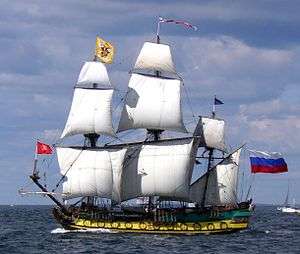Shtandart (frigate, 1999)
 Shtandart under sail in Baltic Sea, 2007 | |
| History | |
|---|---|
| Name: | Shtandart |
| Namesake: | Frigate (1703), Imperial Yacht ship |
| Owner: | Shtandart Project (St Petersburg) |
| Ordered: | 1999 |
| Builder: | Shtandart Project |
| Laid down: | November 4, 1994 |
| Launched: | September 4, 1999 |
| General characteristics (typical) | |
| Class and type: | 24-gun (28-gun after 1710 refit) three-masted frigate |
| Displacement: | 220 tons[1] |
| Length: | |
| Beam: | 6.9 m (23 ft)[1] |
| Height: | 33 m (108 ft) mainmast[1] |
| Draft: | 3.3 m (11 ft)[1] |
| Decks: | Berth, Gun, Spar |
| Propulsion: |
|
| Sail plan: | 620 m2 (6,700 sq ft) on three masts[1] |
| Speed: | 11 knots (20 km/h) |
| Complement: |
|
| Armament: | 24 guns (after 1710 28 guns) |
The frigate Shtandart (Russian: Штандартъ) is modern replica of the first ship of Russia's Baltic fleet, was launched in 1703 at the Olonetsky shipyard near Olonets by the decree of Tsar Peter I and orders issued by commander Aleksandr Menshikov. The name Shtandart was also given to the royal yachts of the tsars until the Russian Revolution in 1917. Tsar Nicholas II's royal yacht was last of this series.
In 1994 a small group of sailing enthusiasts led by Vladimir Martus started construction of a replica of the historical ship. Martus developed a new layout of the Shtandart wherein she was built with four bulkheads, dividing her into five compartments.
The replica frigate has three masts and her displacement is 220 tons. She is 25 metres (82.0 ft) long at her centre line, 27.5 metres (90 ft) long on deck and 34.5 metres (113 ft) long overall. The Shtandart is 6.9 metres (23 ft) wide with a draft of 3.3 metres (11 ft). The ship is designed for speeds between 8-9 knots under sail, and under auxiliary engines required by modern standards up to 15 knots (28 km/h). The original crew complement in 1703 was between 120 and 150, and the modern crew consists of 30 trainees and 10 officers.
The "Shtandart Project" (a non-commercial organisation dedicated to youth development) launched a replica of the frigate on September 4, 1999. The modern Shtandart has two zones:
- The historically accurate area above the gun deck: the steering wheel and helm, all decorative carvings, the furniture, and all of the masts, spikes, guns, gangways and hatches are carefully reconstructed.
- The "modern" area built to modern standards and in compliance with safety regulations: This includes two Volvo Penta TAMD 122P engines and a generator.

Milestones of the Shtandart
- On September 4, 1999 the Shtandart was launched at the Petrovsky Shipyard in St Petersburg.
- In June 2000 the Shtandart set sail on her maiden voyage. The frigate retraced the route taken by Peter I, during his Grand Embassy.
- Since 2005, the Shtandart has played the part of the "dream ship" at the Scarlet Sails festival, an annual celebration of the end of the school year in St. Petersburg from a novel by Alexander Grin[2][3]
- Over the last ten years the Shtandart has sailed approximately 55,000 nautical miles (102,000 km) in the Baltic, North, Norwegian and Barents Seas. She has visited fifty ports in eleven European countries.
Bureaucratic difficulties
Beginning in 2007, all sailing vessels in Russia faced problems with safety certification. The new National Sea and River Authority (then Росморречнадзор/Rosmorrechnadzor, now Госморречнадзор/Gosmorrechnadzor) refused to issue certifications for sailing ships. The Shtandart was one of the most prominent of these vessels, so her dispute with this government agency was widely publicized.[4] The Northwest directorate of the Rosmorrechnadzor cancelled the Shtandart's certifications but the St. Petersburg Arbitration Court reversed the decision favor of the frigate, and the cancellation was ruled illegal.[5] The ship has now been sailing around in Europe for the last few years without plans to return to its home port, to avoid red tape problems.
Shtandart's activities in 2009–2014
- On July 24, 2009 the Shtandart obtained an operations permit and planned to participate in the Tall Ships' Races Baltic 2009 to Kotka and Klaipeda.[6] Bureaucratic red tape delayed its departure from port until August 1, 2009.[7]
- On August 25, 2009 the Shtandart sailed around Norway's North Cape.
- During the winter of 2009–2010, the ship remained in Oslo, Norway, for winter quarters.
- The Shtandart took part in the Sail 2010 tall ships' festival in Bremerhaven, Germany between August 25 and 29.
- The Shtandart took part in the Royal Greenwich Tall Ships Festival in London, UK between September 5 and 9.
References
- 1 2 3 4 5 6 7 "Ship Characteristics" (in Russian). Shtandart. Retrieved 2009-09-11.
- ↑ Brief description of "Scarlet Sails" celebration and other holidays.
- ↑ another "Scarlet Sails" link (Russian).
- ↑ Pirogovsky, Artem (2008-07-10). "Владимир Мартусь: Причина конфликта ""Штандарт" vs Росморречнадзор" - слишком большая сумма контракта" [Vladimir Martus: the Reason for the conflict "Shtandart" vs Rosmorrechnadzor "- too great a contract sum]. Mediaconflict (in Russian). Lenizdat. Retrieved 2009-09-12.
- ↑ Gazeta article about the case.
- ↑ "Shtandart" is out to sea (Russian)
- ↑ "Shtandart" puts out to sea after another delay."
External links
| Wikimedia Commons has media related to Shtandart (ship, 1999). |
- Official Shtandart website (Russian)
- Official Shtandart website (English)
- Shtandart on the Marine Traffic AIS tracking service